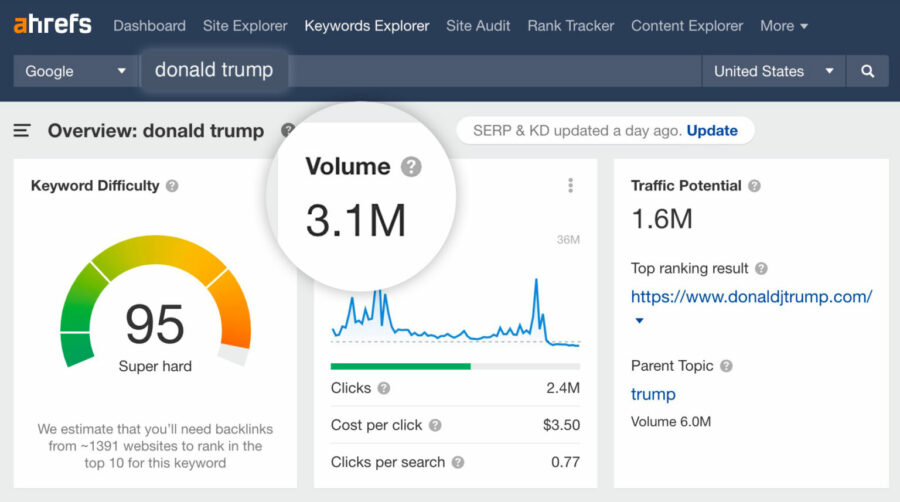Are you ready to boost your website’s visibility and drive more traffic? The secret lies in knowing how to find keyword search volume for the right keywords to target. Understanding keyword search volume and leveraging the top tools to find them is crucial to your SEO success. In this comprehensive guide, we’ll help you decode the power of keyword search volume and optimize your content to rank higher and attract more visitors.
Key Takeaways
- Understanding keyword search volume provides insights into SEO optimization.
- Analyzing data from tools such as Google Keyword Planner and Ahrefs helps generate keyword ideas to target content for maximum success.
- A successful SEO strategy should include a combination of high and low volume keywords, tracked regularly to adapt with changes in competition levels.
Understanding Keyword Search Volume

Keyword search volume is the lifeblood of a powerful SEO strategy. It refers to the monthly frequency of a search query or keyword being entered into search engines. Gaining insights into the Google keyword search volume of various keywords enables better decision-making on which ones to prioritize in your content. By understanding keyword search volumes, you can elevate your rankings in search engine results, thereby driving more traffic to your website.
By understanding the search volume of various keywords, you can find the right ones to make informed decisions on which ones to target in your SEO strategy.
What is Keyword Search Volume?
Search volume for a particular keyword can be calculated by counting the number of searches related to that keyword over a given period. This amount is known as keyword search volume. To get search volume data accurately, interpreting targeted keywords is paramount, taking into account the significance of user intent behind a search for potential ranking. Understanding search volume ranges can help in making informed decisions about keyword targeting.
A successful SEO strategy hinges on providing high-quality, beneficial, and relevant content that incorporates your selected keywords.
Importance of Keyword Search Volume
Keyword search volume plays a pivotal role in determining the success of your SEO and marketing strategies. Analyzing search volume data allows you to identify popular and competitive keywords to focus on, thereby greatly influencing your website’s potential to drive traffic and its search engine optimization.
As user intent is a critical element in achieving high rankings on search engines like Google, it’s important to create helpful and informative content for your site and promote it to gain social signals and backlinks.
Top Tools to Find Keyword Search Volume

There are several top tools available to help you find keyword search volume, such as:
- Google Keyword Planner
- SEMrush
- Ahrefs
- Google Trends
Each tool offers unique features and benefits, allowing you to evaluate keyword search volume and make data-driven decisions for your SEO strategy.
These tools equip you to discover new keywords, assess their performance, and refine your content for enhanced search engine visibility.
Google Keyword Planner
Google Keyword Planner is a free advertising tool that provides valuable keyword research data, including average monthly search volume and competition levels for keywords. To identify relevant keywords, simply click “Discover new keywords” and enter specific keywords or your website URL to determine suitable free keyword options for your content, using the free keyword tool. With a Google Ads account, you can further optimize your keyword strategy to reach your target audience more effectively using the Google Ads Keyword Planner.
Each keyword suggestion provides an average search volume per month and competition level, helping you make informed decisions on which keywords to target.
SEMrush
SEMrush is a versatile tool that offers various features to analyze keyword search volume, such as Keyword Overview and Keyword Magic Tool. With SEMrush, you can input a desired keyword and receive a report displaying the keyword’s regional and global search volume, along with other useful metrics.
Additionally, you can explore related keywords and their search volumes to expand your list of targeted keywords.
Ahrefs
Ahrefs is another comprehensive tool that provides keyword search volume data through its Webmaster Tools and Keyword Difficulty Checker. By using Ahrefs, you can filter keywords based on various metrics such as search volume, keyword difficulty, and more, helping you identify the most valuable keywords for your SEO strategy.
This data-driven approach can give you an edge over your competition in search engine rankings.
Google Trends
Google Trends is a free tool that displays the relative popularity of search terms over time, making it useful for identifying trending keywords and seasonal fluctuations. By inputting a trending topic into Google Trends, you can gain insights into the popularity of your topics and whether you can anticipate a growing trend for a given topic.
This information can help you adapt your keyword strategy and stay ahead of the curve.
How to Conduct Keyword Research

Conducting effective keyword research is a crucial step in optimizing your content for search engines. The process involves identifying relevant topics, generating keyword ideas, and analyzing keyword metrics to prioritize your target keywords.
By utilizing the top tools mentioned earlier and following a systematic approach, you can uncover valuable keywords that will boost your website’s visibility and drive more organic traffic.
Identifying Relevant Topics
The first step in conducting keyword research is to identify important topics relevant to your business or industry. By creating a list of these topics and using keyword research tools, you can find keywords related to these topics and expand your list of relevant content ideas.
Exploring keyword suggestions and variations can help you uncover hidden gems that people are searching for, giving you a competitive edge in search engine rankings.
Generating Keyword Ideas
Once you have identified relevant topics, the next step is to generate keyword ideas using tools like Google Keyword Planner, SEMrush, and Ahrefs. These tools can help you discover new and related keywords, along with their search volumes and competition levels.
By analyzing this data, you can prioritize which keywords to target and optimize your content accordingly.
Analyzing Keyword Metrics
After generating keyword ideas, it’s essential to analyze keyword metrics such as search volume, competition, and keyword difficulty to prioritize your target keywords. Understanding these metrics allows you to focus your efforts on the keywords most likely to yield the best results.
This data-driven approach can help you optimize your content for better search engine visibility and drive more targeted traffic to your website.
Optimizing Content for High-Volume Keywords

Optimizing your content for high-volume keywords is crucial for capturing your target audience’s attention and driving more traffic to your website. By incorporating these high-traffic keywords into your content, you can improve your search engine rankings and increase the chances of attracting more visitors.
This section will detail how to craft quality content and apply on-page SEO techniques for high-volume keyword optimization.
Creating Quality Content
Creating high-quality, relevant content that addresses user intent is the backbone of a successful SEO strategy. By understanding the search intent of your target keywords and crafting informative, valuable, and engaging content, you can satisfy your users’ needs and improve your website’s search engine rankings.
Additionally, incorporating on-page SEO techniques and using a variety of content formats can enhance your content’s readability, navigability, and overall appeal.
On-Page SEO Techniques
On-page SEO techniques are essential for optimizing your content to rank higher in search engine results. These techniques include optimizing title tags, meta descriptions, and header tags to improve visibility for high-volume keywords and effectively utilizing keywords for SEO.
By including your targeted high-volume keywords in these HTML elements, you can enhance your content’s relevancy and increase the chances of attracting more organic traffic.
Balancing High-Volume and Low-Volume Keywords

A well-rounded SEO strategy involves targeting a mix of high-volume and low-volume keywords. While high-volume keywords can generate increased traffic in the short-term, low-volume keywords can help establish a more sustainable presence in the long run.
This section will delve into the value of long-tail, low-volume keywords and the importance of a diverse keyword approach for achieving both immediate and future results.
The Value of Long-Tail Keywords
Long-tail, low-volume keywords are valuable for niche industries and specific content strategies, offering lower competition and higher conversion rates. These keywords are longer phrases that are more targeted to a particular audience or topic, making them easier to rank for and more likely to result in higher conversions.
By incorporating long-tail keywords into your content, you can target a more precise audience and increase the chances of turning visitors into customers.
Diversifying Keyword Strategy
Diversifying your keyword strategy by targeting a mix of high-volume and low-volume keywords allows you to cater to both short-term and long-term goals. High-volume keywords can provide immediate boosts in traffic, while low-volume keywords can help build a more consistent presence in search engine rankings.
By striking a balance between the two, you can create a robust and sustainable SEO strategy that drives continuous growth.
Monitoring Keyword Performance and Adjusting Strategy
Regularly monitoring keyword performance and adjusting your strategy based on changes in search volume, competition, and website performance is crucial for maintaining and improving your SEO rankings.
Utilizing tools such as Google Search Console, SEMrush Position Tracking, and Ahrefs enables you to monitor keyword rankings, website traffic, and conversions, affording you a competitive edge.
Tracking Keyword Rankings
![]()
Keeping an eye on your keyword rankings is essential for understanding the effectiveness of your SEO strategy. Tools like Google Search Console, SEMrush Position Tracking, and Ahrefs allow you to track your website’s performance for specific keywords and monitor changes in search engine rankings.
Regular evaluation of your keyword rankings uncovers areas for improvement, enabling the optimization of your content based on data-driven decisions.
Adapting to Changes in Search Volume and Competition
Staying agile and adapting your keyword strategy based on changes in search volume, competition, and website performance is crucial for maintaining and improving your SEO rankings. Regular review of your keyword performance and making necessary adjustments ensures your content maintains relevancy and visibility in search engine results.
This proactive approach will help you stay ahead of your competition and continue driving targeted traffic to your website.
Summary
In conclusion, mastering the art of finding keyword search volume and optimizing your content for high-volume keywords is essential for a successful SEO strategy. By understanding keyword search volume, leveraging top tools, conducting effective keyword research, and implementing on-page SEO techniques, you can improve your website’s visibility, drive more traffic, and ultimately, achieve your business goals. Stay agile, monitor keyword performance, and adapt your strategy as needed to stay ahead of the competition and continue driving growth.
Frequently Asked Questions
How do I find low search volume keywords?
To identify low search volume keywords and improve your SEO results, mine user-generated content and communities, monitor social media for conversational language, gather keyword ideas from YouTube, and talk to your customer support team.
How to search keywords?
To search for specific words on a webpage, press Ctrl+F (Windows) or Command+F (Mac), type the word in the search field, and check the keyword presence and/or number of keywords (density) to locate the desired information.
Is google keyword planner free?
Yes, Google Keyword Planner is free to use, but it requires a Google Ads account. Once you have an account, Keyword Planner will help you research keywords for your Search campaigns, discover new keywords related to your business, and see estimates of the searches they receive and the cost to target them.
What is keyword search volume?
Keyword search volume is the number of times a search query or keyword is used each month, making it essential for successful SEO optimization.
What tools can I use to find keyword search volume?
To determine keyword search volume, Google Keyword Planner, SEMrush, Ahrefs, and Google Trends are excellent tools to consider.
